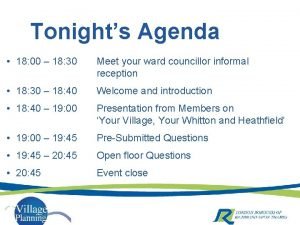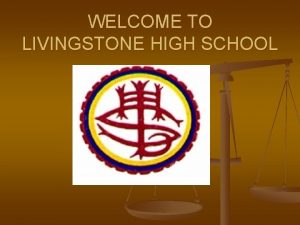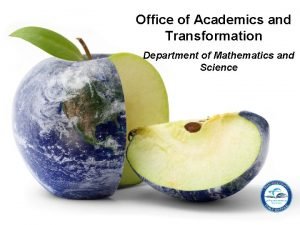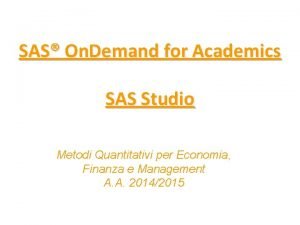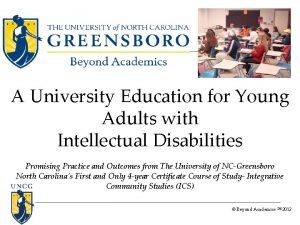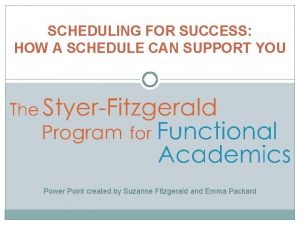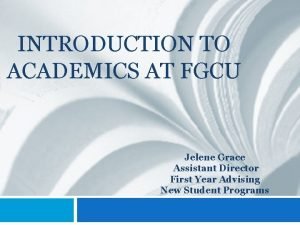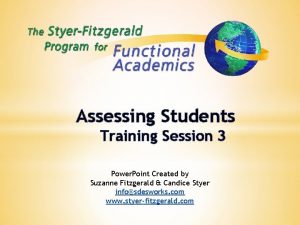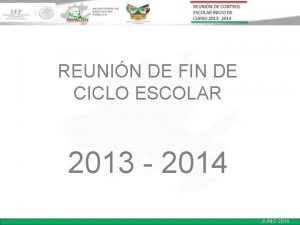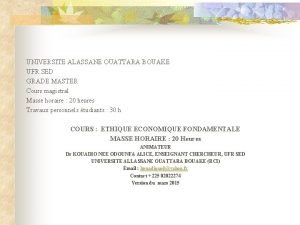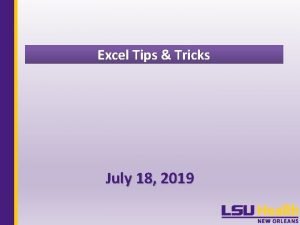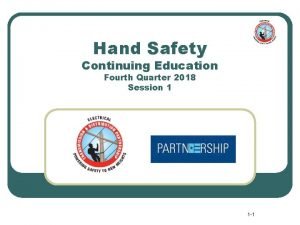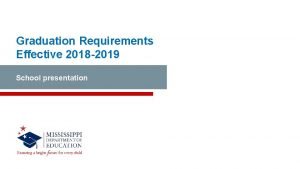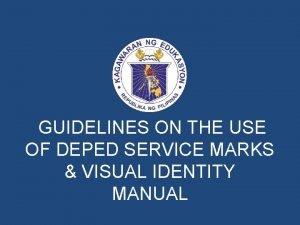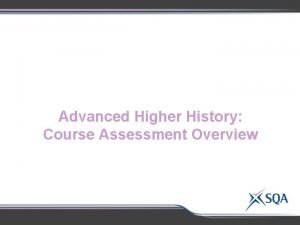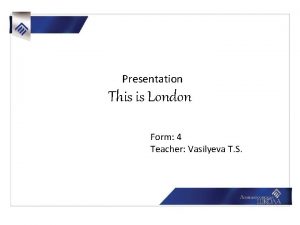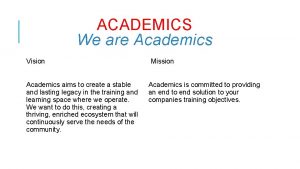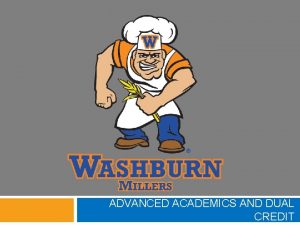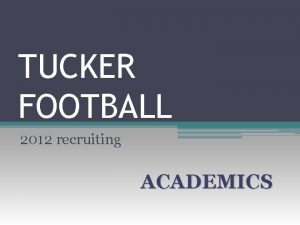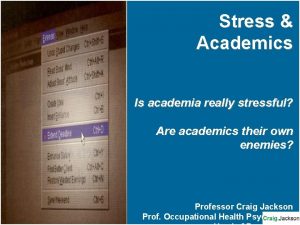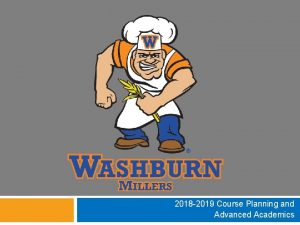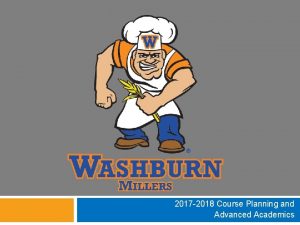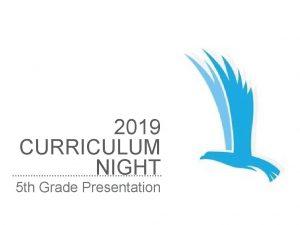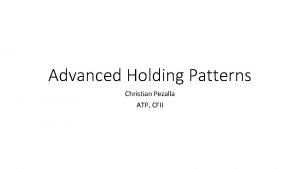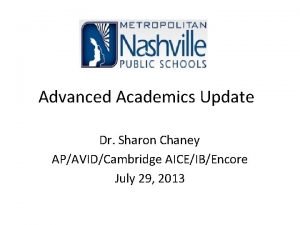Advanced Academics 2018 2019 Tonights Presentation History of






















- Slides: 22

Advanced Academics 2018 -2019

Tonight’s Presentation ○ ○ ○ History of Advanced Academics Department D 105 Advanced Academics Services Identification/Appeals criteria Department staffing Department communication “It is not high ability (high achievers) itself that creates a need for intervention; rather, it is a mismatch between the child’s ability and the pacing, depth, and content of the instruction provided that creates the need for intervention. ” (BGE, p. 27) 2

History of Advanced Academics Department

History of High Ability Programming Prior to 2013 - SAIL Model ○ Identification of students in 3 rd grade ○ Only ELA ○ Limited flexibility during year for enrichment AAD Model ○ Flexible delivery model - servicing students as they present need ○ Students flexibly receive enrichment during portion of or full unit of instruction ○ Push in; pull out; co-teaching; collaborative planning AAD Timing ○ Began 2013 - one math specialist ○ 2014 - additional math specialist; two ELA specialists ○ 2017 - additional 0. 6 math specialist Current Staffing ○ 2. 4 FTE Math specialists ○ 2. 0 FTE ELA specialists ○ 0. 6 FTE Accelerated Math Teachers 4

History of High Ability Programming S. A. I. L. Program (Scholarly Advancement In Learning) Pull-out only enrichment ○ 4 th - 6 th grade ○ Twice a week – 60 minutes Separate program - Not connected to classroom units Identification process - annual ○ Aptitude - Cog. AT Aptitude Screener ○ Achievement – MAP multiple measures ○ Teacher Input Appeals process ○ Additional data points ○ Parent and Teacher input “Gifted” label 5

D 105 Advanced Academics Services

Advanced Academics Department Services K-4 Math & 3 -6 ELA Specialist § § Meet the needs of our high-ability students Find and foster Small, flexible groups of students focused on extending the core Collaborative planning with classroom teachers - connected to core § Regularly review data § Student needs change, thus flexible/changing groups 7 -8 Advanced Reading § Extension and enrichment beyond grade-level core standards § Student identification begins at end of 6 th grade § Multiple entry points 5 -8 Accelerated Math § Full grade level acceleration - next grade level’s core standards § Student identification begins at end of 4 th grade § Multiple entry points 7

Advanced Academics - ELA/Math Specialist Goals 1. Extend and enrich for high-ability students ○ ○ A deeper investigation of unit standards Acceleration to next grade level standards (when appropropriate). A combination of push in or pull out groupings Consultative support to best differentiate and support high-ability learners in classroom 2. Find and foster high-achieving abilities ○ Addressing the underrepresented populations 3. Build teacher capacity to better differentiate for our highest ability students ○ ○ Regular collaborative planning with teachers Co-teach with classroom teachers to extend core instruction Model strategies to reach highest ability learners (i. e. during shared instruction, number talks) Support with building level and district level professional development 8

ELA and Math Specialists staffing

Advanced Academic Staffing Building ELA Specialists Days Math Specialists Days Hodgkins 2 days 3 days Ideal 2. 5 days 3 days Seventh 2. 5 days 3 days Spring 3 days 10

Identification/ Appeals criteria Math and ELA Specialists - Data Analysis Process Advanced Reading Accelerated Math Appeals Process Beyond 8 th Grade

Multiple Data Points Examined by Specialists Data examined to best identify enrichment/extension needs of students: : ➢ ➢ ➢ ➢ ➢ MAP overall RIT score MAP overall percentile ranking Unit strand MAP RIT Cog. AT : Verbal, Non-verbal, Quantitative Pre-Test scores Reading benchmarks Pre-test extension problems PARCC scores Other formative classroom data Specialists examine combinations of data points* from the above list to best determine instructional needs and flexible groupings of highachieving students in any given classroom. (*Specific data examples will be shared during presentation) 12

Advanced Academics Specialists HOW We Meet Diverse Student Needs Consultative Support Small Group Support Teacher and specialist engage in collaborative planning to best support high ability learners ● Focus on strong instructional strategies ● Focus on strong ● Focus on best resources instructional strategies ● Focus on challenging task ● Focus on best resources ● Focus on challenging tasks Planning and Instruction are shared allowing both classroom teacher and specialist to meet with “identified” students. Co-planned instruction is then delivered to students by classroom teacher. Some opportunities for co-teaching may also happen here. Intensity of student support increases based on student need. This intensive support is primarily planned and executed by specialist either in or out of the classroom setting. ILP Individualized Learning Plan Specialized support for students showing intensive level of need. 13

Advanced Academic Specialists WHAT We Do to Meet Diverse Student Needs ● Solidifying core instruction with resources and instructional design ideas ● Differentiating of Core ideas and resources ● Increasing complexity through the use of Bloom’s Taxonomy and Depth of Knowledge (DOK). ● Raising the level of rigor in student discussion through questioning strategies ○ Accountable talk ● Using higher level text in guided discussion ● Implementing Problem-Based-Learning ● Compacting curriculum and accelerated pacing during units of instruction ● Authentic problems solving experiences at an increased level of rigor/higher standards ● Number talks - high ceiling/low floor ● Providing higher level math/ELA tasks to enrich core instruction or beyond grade level core ○ Exemplars - high level math tasks ○ News. ELA - multiple lexile level reading passages 14

Advanced Reading and Accelerated Math Identification

IDENTIFICATION for ADVANCED LITERATURE SERVICES For Initial Placement in Advanced Lit in 7 th Grade All students will be considered using these three criteria Appeal ACHIEVEMENT APTITUDE/ABILITY ACADEMIC BEHAVIORS PERFORMANCE TASK MAP Cog. AT Teacher Input Reader’s Response (85% +) 2 out of last 4 measures (Stanine 7, 8, 9) Input provided by multiple educators based on PARCC Rubric 16

IDENTIFICATION for ACCELERATED MATH SERVICES For Initial Placement in Accelerated Math in 5 th Grade All students will be considered using these three criteria Appeal ACHIEVEMENT APTITUDE ACADEMIC BEHAVIORS PERFORMANCE TASK MAP Cog. AT Teacher Input Math Task (85% +) (Stanine 7, 8, 9) 2 out of last 4 measures Form 7 Screener Input provided by multiple based on Exemplars Rubric educators **Grade Level Stanine 17

Beyond 8 th Grade ➢ The process doesn’t stop. There are several pieces of data that we look at. ➢ Things we consider…. ○ Love of math and/or ELA (this is a challenge in American mathematics - sometimes why we move in later than earlier) ○ Previous years scores ○ Pacing ○ Work Ethic and Maturity ○ Academic Readiness versus Hard Worker ○ Enjoyment and Interest ○ Other high-level classes 18

Beyond 8 th Grade 2017 -2018 8 th Grade 9 th Grade Placement Math 23% (43/167) 66% ELA 27. 5% (46/167) 60% 2016 -2017 8 th Grade 9 th Grade Placement Math 22% ( 35 /156 ) 56% ELA 29% (46/156) 55% 19

Department Communication

Communication ● ● ● Unit letters Learning Management System (LMS) access i. e. Google Classroom and Schoology Phone calls Personal conferences and conferences with classroom teachers Curriculum Nights 21

Research Take. Aways • Beyond Gifted Education: Designing and Implementing Advanced Academic Programs – Peters, Matthews, Mc. Bee, & Mc. Coach (2014) • Best Practices in Gifted Education: An Evidence-Based Guide – Robinson, Shore, & Enersen (2007) • Re-Forming Gifted Education: How Parents and Teachers Can Match the Program to the Child – Rogers (2002)
 Tonight's agenda
Tonight's agenda Livingstone high school
Livingstone high school Office of academics and transformation
Office of academics and transformation Sas on demand for academic
Sas on demand for academic Beyond academics uncg
Beyond academics uncg Styer fitzgerald sight words
Styer fitzgerald sight words Aspiring academics
Aspiring academics Fgcu engineering advising
Fgcu engineering advising Styer fitzgerald functional academics
Styer fitzgerald functional academics B a f c j e
B a f c j e Conest sep hidalgo 2021
Conest sep hidalgo 2021 Ufr sed bouaké
Ufr sed bouaké Excel tips and tricks 2019
Excel tips and tricks 2019 Hand safety presentation 2018
Hand safety presentation 2018 Presentation of graduates 2018
Presentation of graduates 2018 Advanced persistent threat presentation
Advanced persistent threat presentation Deped service manual
Deped service manual Ap world history dbq 2018
Ap world history dbq 2018 Higher history course specification
Higher history course specification Advanced higher english dissertation word limit
Advanced higher english dissertation word limit Diameters of fetal head
Diameters of fetal head Cephalic presentation
Cephalic presentation History of london presentation
History of london presentation
